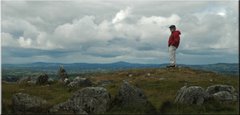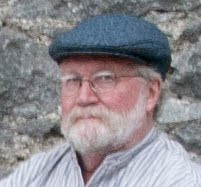We took the day off and traveled North to San Francisco again last Friday, this time to visit a trendy little restaurant with our friend Lucile. The restaurant is the café in the de Young museum of fine art in Golden Gate Park.
Last April we took a similar weekday trek, documented in the blog entry you can see by clicking here. On that trip we visited the de Young’s sister museum, the Legion of Honor. The de Young is a larger and more modern institution. It re-opened in 2005 after its old building had been torn down in 2000 and a new, stunning architectural marvel built on its old footprint. Our visit was on a densely-foggy day, so I have no external views of the building (but you can see one on the museum’s website by clicking here.) Its interior and surrounding grounds are every bit as much works of art as any item they contain.
Please click on any image to see a much larger, better version.
There are airy spaces…
The Piazzoni Murals Room
… passageways that lead the eyes and then the body to follow them…
… startling things in lofty places…
… odd creatures in exterior spaces…
 Zhan Wang’s “Artificial Rock” appears to lumber toward a museum entrance.
Zhan Wang’s “Artificial Rock” appears to lumber toward a museum entrance.
… and exterior gathering places whose attraction isn’t hard to pin down.
Like the Legion of Honor, the de Young has a vast permanent collection of classical and historic works.
 Visitors contemplate Frederic Edwin Church’s “Rainy Season in the Tropics” (1866)
Visitors contemplate Frederic Edwin Church’s “Rainy Season in the Tropics” (1866)
However, possibly because of the innovative nature of the physical place itself, the de Young’s permanent collection seems to have a greater presence of works of whimsy, or experiment, or current social impact than the Legion of Honor:
Who hasn’t felt like this once in a while? (I didn’t record the sculptor’s name or the title of this piece, but will make a point to do so on our next visit.)
 “Rover’s Garden Grows” (1991) by Dale Chihuly and Italo Scanga
“Rover’s Garden Grows” (1991) by Dale Chihuly and Italo Scanga
 “Cod Tureen” (1997) by David Regan. Modeled after Hieronymus Bosch’s “The Large Fishes Devouring the Small Fishes,” this is a working tureen. I doubt very much that I would have the stomach to eat anything that came out of it, though.
“Cod Tureen” (1997) by David Regan. Modeled after Hieronymus Bosch’s “The Large Fishes Devouring the Small Fishes,” this is a working tureen. I doubt very much that I would have the stomach to eat anything that came out of it, though.
Perhaps it was a vestige of a dark mood, but the most moving things to me that I saw that afternoon were two works directly adjacent to one another, made of the most mundane materials: concrete, old furniture, and burned wood.
 Detail in Cornelia Parker’s “Anti-Mass” (2005)
Detail in Cornelia Parker’s “Anti-Mass” (2005)
The plaque on the wall next to this free-hanging cube of pieces of burned wood reads, in part: “This sculpture is constructed from the charred remains of a Southern Black Baptist church that was destroyed by arsonists. […] Parker’s cube appears to defy gravity, providing a monumental object for quiet meditation and reflection."
The above photo shows the entire work, but by necessity only in two dimensional projection, which diminishes its impact by several orders of magnitude. The little object on the floor to the right of the cube is this item:
 Untitled sculpture by Doris Salcedo (1998)
Untitled sculpture by Doris Salcedo (1998)
The plaque for Salcedo’s piece reads, “Colombian-born sculptor Doris Salcedo uses a common household artifact to register the loss of human life to political violence in her native country. Encasing a side chair […] in rebar and cement, she transforms a familiar object into [a] disturbing record of the people who have disappeared, a haunting reminder of those citizens who have suffered the effects of civil war and government corruption. Although she has eliminated references to blood and corpses in her work, Salcedo registers her protest just as vividly through her juxtaposition of humble, domestic artifacts and brutal building materials.”
These are just a few of the 108 photos we saved from the visit, and we have at least tenfold more images in our minds’ eyes. If you are ever in San Francisco and have half a day to spare, you could do much worse than spend it at the de Young or the Legion of Honor. Of course, you don’t have to physically visit San Francisco to enjoy their web presence.
 Mrs. Fort (in red) and Lucile on the lower floor of the museum’s store.
Mrs. Fort (in red) and Lucile on the lower floor of the museum’s store.
We visited with Lucile for a while both before and after our museum adventure. More precisely, we visited with Lucile and…
… with Terri, and…

… with Shady, and…
… with DP. Three more stunning works of fine art.
=====================











2 comments:
We went to the De Young a few months ago and I was tremendously impressed by "Anti-Mass" as well, even before I read about its origin. You're right, the 2-D view doesn't do it justice. I spent several minutes just walking around the thing in fascination.
My general impression is that the New De Young is leaner and hipper than it used to be, a bit too much so for my taste. It's nice that the art isn't crammed together and has some space to breathe; on the other hand, it felt to me like the old museum delivered a lot more bang for the buck (or per square foot). But I loved the Old De Young, so that may just be wounded nostalgia talking.
Nice report, thanks!
"Leaner and hipper" is a very, very good and efficient way of expressing the metamorphosis, Brian, and one that I wish I had come up with.
Diane, by the way, agrees with you 100%. As a San Francisco native, though, her opinions are likely to be weighted toward the usta-be is betta-be end of the spectrum. I'm from the crude realm of upstate New York, though, and possibly can be forgiven for being gleefully entertained by the new de Young's shiny objects.
Of which it has many.
Post a Comment